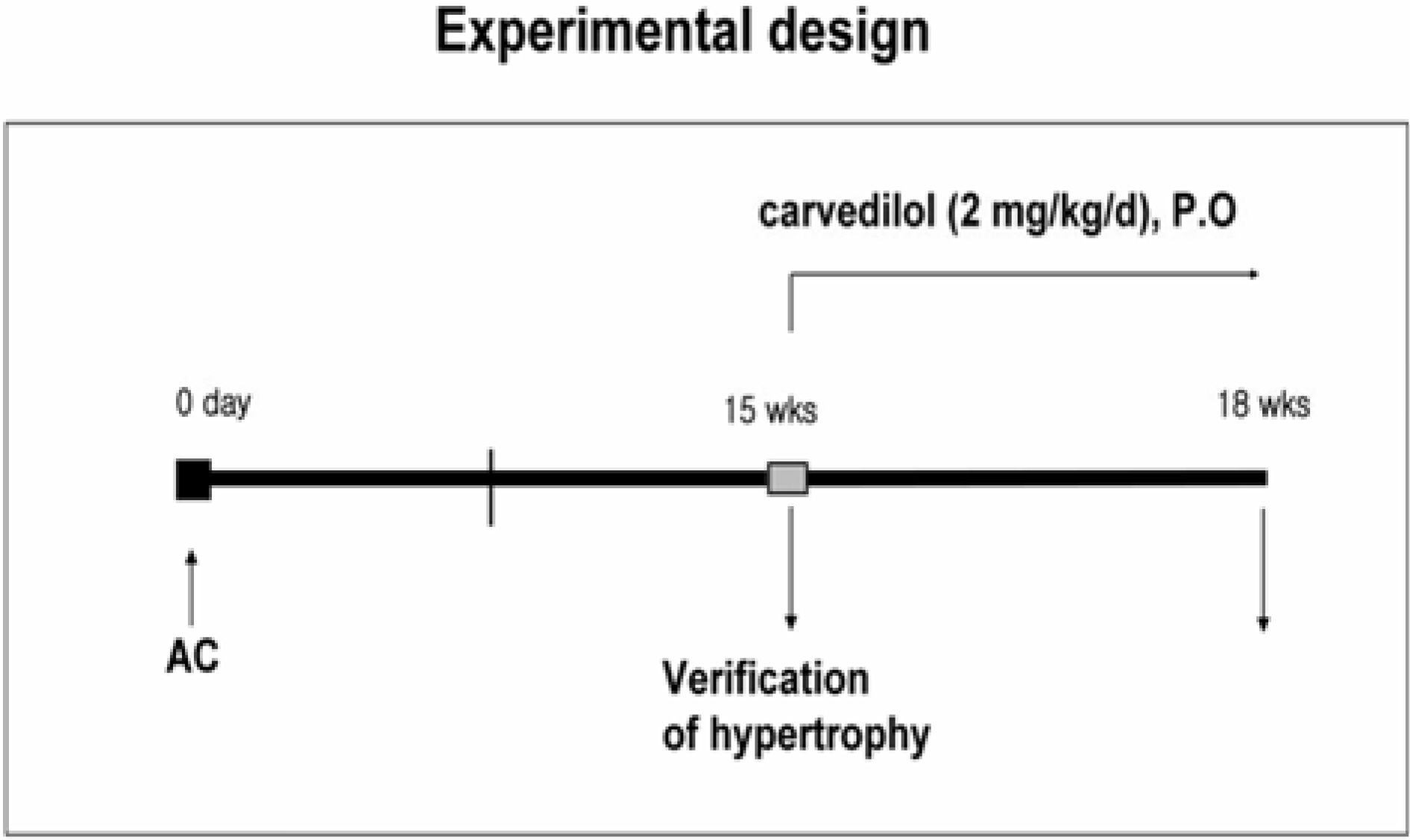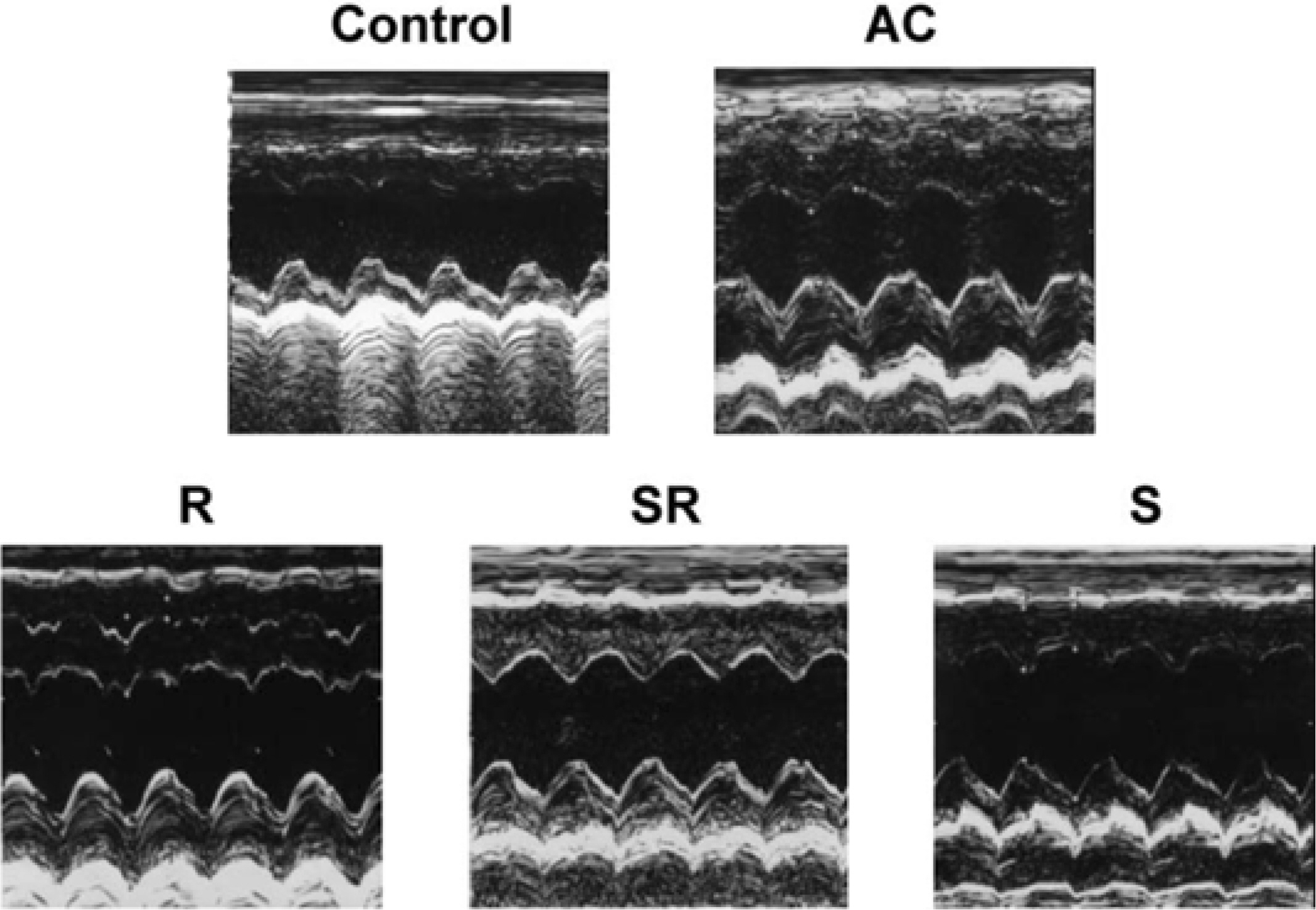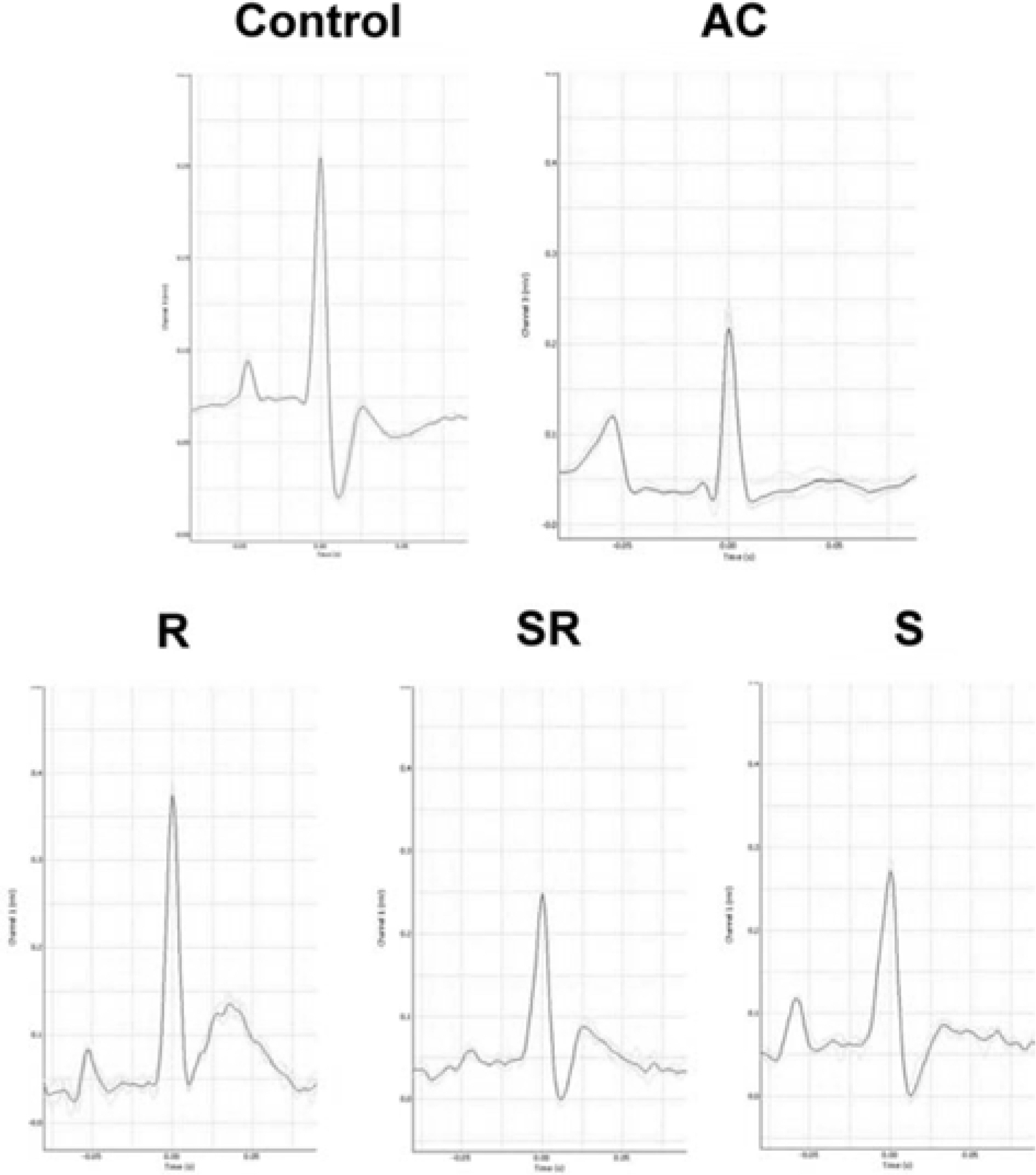Lab Anim Res.
2010 Mar;26(1):75-82. 10.5625/lar.2010.26.1.75.
Comparing the Effects of Carvedilol Enantiomers on Regression of Established Cardiac Hypertrophy Induced by Pressure Overload
- Affiliations
-
- 1Department of pharmacology, Shantou University Medical College, Shantou, Guangdong, China.
- 2Department of Pharmacology, College of Medicine and BK21 Chungbuk Biomedical Science Center, Chungbuk National University, Cheongju, Korea. kch@chungbuk.ac.kr
- KMID: 1458943
- DOI: http://doi.org/10.5625/lar.2010.26.1.75
Abstract
- Pressure overload diseases such as valvular stenosis and systemic hypertension morphologically manifest in patients as cardiac concentric hypertrophy. Preventing cardiac remodeling due to increased pressure overload is important to reduce the morbidity and mortality. A recent clinical study has shown that carvedilol has beneficial effects on the survival rate of patients with heart failure. This may be due to the actions of carvedilol such as beta-adrenoceptor blockade and the alpha1-adrenergic receptor blockade effects. Therefore, we investigated whether carvedilol can reverse preexisting cardiac hypertrophy and we compared the effects of racemic carvedilol and the carvedilol enantiomers. Cardiac hypertrophy was induced in rats by suprarenal transverse abdominal aortic constriction (AC). Fifteen weeks after AC surgery, concentric hypertrophy was identified in the AC group by performing echocardiography. Low dose S- and SR-carvedilol (2 mg/kg/day), which were orally administered for three weeks, caused significant regression of the cardiac hypertrophy, and this most significantly occurred in the rats that received S-carvedilol. However, R-carvedilol did not reduce cardiac hypertrophy. Regression of cardiac hypertrophy by carvedilol was confirmed on the echocardiograms and electrocardiograms. These results suggest that carvedilol could reverse the development of leftventricular concentric hypertrophy that is induced by pressure overload. S-carvedilol is proposed to be superior to SR-and R-carvedilol as a beneficial treatment for cardiac hypertrophy.
MeSH Terms
Figure
Reference
-
Baba H.A.., Iwai T.., Bauer M.., Irlbeck M.., Schmid K.W.., Zimmer H.G.1999. Differential effects of angiotensin II receptor blockade on pressure-induced left ventricular hypertrophy and fibrosis in rats. J. Mol. Cell. Cardiol. 31:445–455.
ArticleBartsch W.., Sponer G.., Strein K.., Muller-Beckmann B.., Kling L.., Bohm E.., Martin U.., Borbe H.O.1990. Pharmacological characteristics of the stereoisomers of carvedilol. Eur. J. Clin. Pharmacol. 38 (Suppl. 2), S104-S107.Bohm M.., Laragh J.H.., Zehender M.1992. From Hypertension to Heart Failure. pp. 177-205, Springer, Berlin.Bril A.., Slivjak M.., Dimartino M.J.1992. Cardioprotective effects of carvedilol, a novel β-adrenoceptor antagonist with vasodilation properties, in anaesthetized minipigs: comparison with propranolol. Cardiovasc. Res. 26:518–525.Bristow M.R.., Gilbert E.M.., Abraham W.T.., Adams K.F.., Fowler M.B.., Hershberger R.E.., Kubo S.H.., Narahara K.A.., Ingersoll H.., Krueger S.., Young S.., Shusterman N.1996. Carvedilol produces dose-related improvements in left ventricular function and survival in subjects with chronic heart failure. Circulation. 94:2807–2816.
ArticleCohn J.N.., Fowler M.B.., Bristow M.R.., Colucci W.S.., Gilbert E.M.., Kinhal V.., Krueger S.K.., Lejemtel T.., Narahara K.A.., Packet M.., Young S.T.., Holcslaw T.L.., Lukas M.A.1997. Safety and efficacy of carvedilol in severe heart failure. J. Card. Failure. 3:173–179.
ArticleColucci W.S.., Wynne J.., Holman B.L.., Braunwald E.1980. Longterm therapy of heart failure with prazosin: a randomized double blind trial. Am. J. Cardiol. 45:337–344.
ArticleDupont A.G.1990. Effects of carvedilol on renal function. Eur. J. Clin. Pharmacol. 38 (Suppl. 2), S96-S100.Esposito G.., Rapacciuolo A.., Naga Prasad S.V.., Takaoka H.., Thomas S.A.., Koch W.J.., Rockman H.A.2002. Genetic alterations that inhibit in vivo pressure-overload hypertrophy prevent cardiac dysfunction despite increased wall stress. Circulation. 105:85–92.
ArticleFujimaki M.1992. Stereoselective disposition and tissue distribution of carvedilol enantiomers in rats. Chirality. 4(3):148–154.
ArticleGilbert E.M.., Olsen S.L.., Renlund D.G.., Bristow M.R.1993. β-adrenergic receptor regulation and left ventricular function in idiopathic dilated cardiomyopathy. Am. J. Cardiol. 71, 23C-29C.Gregorini L.., Marco J.., Palombo C.., Kozàkovà M.., Anguissola G.B.., Cassagneau B.., Bernies M.., Distante A.., Marco I.., Fajadet J.., Zanchetti A.1998. Postischemic left ventricular dysfunction is abolished by alpha-adrenergic blocking agents. J. Am. Coll. Cardiol. 31:992–1001.Hill J.A.., Karimi M.., Kutschke W.., Davisson R.L.., Zimmerman K.., Wang Z.., Kerber R.E.., Weiss R.M.2000. Cardiac hypertrophy is not a required compensatory response to short-term pressure overload. Circulation. 101:2863–2869.
ArticleLi J.., Li P.., Feng X.., Li Z.., Hou R.., Han C.., Zhang Y.2003. Effects of losartan on pressure overload-induced cardiac gene expression profiling in rats. Clin. Exp. Pharmacol. Physiol. 30:827–832.
ArticleLong C.S.., Kariya K.., Karns L.., Simpson P.C.1992. Sympathetic modulation of the cardiac myocyte phenotype: studies with a cell-culture model of myocardial hypertrophy. Basic Res. Cardiol. 87:19–31.
ArticleMosterd A.., Hoes A.W.., de Bruyne M.C.., Deckers J.W.., Linker D.T.., Hofman A.., Grobbee D.E.1999. Prevalence of heart failure and left ventricular dysfunction in the general population; The Rotterdam Study. Eur. Heart J. 20:447–455.
ArticleMurray C.J.., Lopez A.D.1997. Mortality by cause for eight regions of the world: Global Burden of Disease Study. Lancet. 349:1269–1276.
ArticlePacker M.1998. Beta-adrenergic blockade in chronic heart failure: principles, progress, and practice. Prog. Cardiovasc.Poole-Wilson P.A.., Swedberg K.., Cleland J.G.., Di Lenarda A.., Hanrath P.., Komajda M.., Lubsen J.., Lutiger B.., Metra M.., Remme W.J.., Torp-Pedersen C.., Scherhag A.., Skene A.2003. Comparison of carvedilol and metoprolol on clinical outcomes in patients with chronic heart failure in the Carvedilol or Metoprolol European Trial (COMET): randomised controlled trial Lancet. 362:7–13.Stahl E.., Mutschler E.., Baumgartner U.., Spahn-Langguth H.1993. Carvedilol stereopharmacokinetics in rats: affinities to blood constituents and tissues. Arch. Pharm. (Weinheim). 326(9):529–533.
ArticleVentura H.O.., Malik F.S.., Mehra M.R.., Stapleton D.D.., Smart F.W.1997. Mechanisms of hypertension in cardiac transplantation and the role of cyclosporine. Curr. Opin. Cardiol. 12:375–381.
ArticleWatanabe K.., Ohta Y.., Nakazawa M.., Higuchi H.., Hasegawa G.., Naito M.., Fuse K.., Ito M.., Hirono S.., Tanabe N.., Hanawa H.., Kato K.., Kodama M.., Aizawa Y.2000. Low dose carvedilol inhibits progression of heart failure in rats with dilated cardiomyopathy. Br. J. Pharmacol. 130(7):1489–1495.
Article
- Full Text Links
- Actions
-
Cited
- CITED
-
- Close
- Share
- Similar articles
-
- ERRATUM: Comparing the Effects of Carvedilol Enantiomers on Regression of Established Cardiac Hypertrophy Induced by Pressure Overload
- Epigallocatechin-3 gallate prevents cardiac hypertrophy induced by pressure overload in rats
- Establishment and Magnetocardiographic Changes of Pressure Overload Left Ventricular Hypertrophy and Its Regression in Rats
- Role of Calcineurin-Dependent Signaling Pathway on the Left Ventricular Hypertrophy Induced by Pressure Overload
- EGCG Blocked Phenylephrin-Induced Hypertrophy in H9C2 Cardiomyocytes, by Activating AMPK-Dependent Pathway





